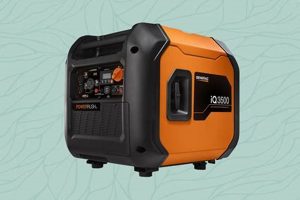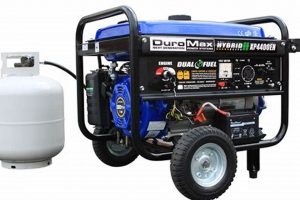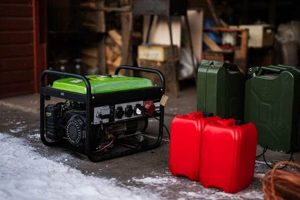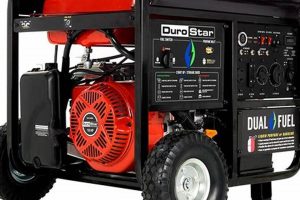Determining the appropriate generator capacity for residential use involves calculating the total wattage required to power essential appliances and devices during a power outage. This involves identifying necessary appliances, determining their starting and running wattage, and adding those wattages together to arrive at a total power requirement. For example, a refrigerator might require 1,000 starting watts and 200 running watts, while a sump pump might need 800 starting watts and 500 running watts. Understanding these power demands helps select a generator capable of handling the load.
Accurate generator sizing ensures sufficient power for critical systems during outages, preventing disruptions to daily life, protecting sensitive electronics, and maintaining safety and comfort. Historically, generator selection was often based on rough estimations or limited appliance coverage. However, with the increasing reliance on electricity for essential functions, including security systems, medical equipment, and communication devices, precise power calculations have become vital. A correctly sized generator offers peace of mind and prevents costly under- or over-sizing mistakes.
The process of determining the correct generator size involves several key steps: creating a comprehensive list of necessary appliances, identifying their respective power requirements, calculating total wattage needs including starting wattage surges, and considering future power needs. Each of these steps will be explored in detail.
Tips for Sizing a Portable Generator
Accurately determining generator capacity is crucial for effective power backup. The following tips provide guidance for this process.
Tip 1: Inventory Essential Appliances: Create a comprehensive list of all appliances requiring power during an outage. This list should prioritize essential items such as refrigerators, freezers, sump pumps, furnaces, and medical equipment.
Tip 2: Determine Wattage Requirements: Identify the starting and running wattage for each appliance. This information is typically found on the appliance’s data plate or in the owner’s manual. Starting wattage, often significantly higher than running wattage, represents the power surge required to initially start the motor.
Tip 3: Calculate Total Wattage: Add the running wattages of all intended appliances. Then, add the highest starting wattage from the list to this sum. This total represents the minimum generator capacity required.
Tip 4: Account for Future Needs: Consider potential future appliance additions and incorporate their estimated wattage requirements into the calculation. This prevents the need to upgrade the generator later.
Tip 5: Consider Generator Type: Inverter generators offer more stable power for sensitive electronics, while conventional generators are generally more cost-effective for powering basic appliances. Factor the types of appliances being powered into the generator selection process.
Tip 6: Consult a Qualified Electrician: For complex electrical systems or specialized equipment, consult a qualified electrician to ensure proper generator sizing and safe installation.
Tip 7: Prioritize Safety: Always operate generators outdoors in a well-ventilated area, away from windows and doors, to prevent carbon monoxide poisoning.
Accurate generator sizing ensures sufficient power availability during outages, preventing disruptions and protecting essential systems. By following these tips, individuals can select a generator that meets their specific needs and provides reliable backup power.
By following these tips, homeowners can confidently select a generator that meets their specific power needs during outages. The subsequent sections will delve into more detailed aspects of generator selection and installation.
1. Calculate wattage requirements.
Accurate generator sizing hinges on a precise understanding of power demands. Calculating wattage requirements provides the foundation for selecting a generator capable of handling the anticipated load during a power outage. This process involves identifying essential appliances, determining their individual power consumption, and aggregating these values to arrive at a comprehensive power profile.
- Identify Essential Appliances:
Begin by listing appliances requiring power during an outage. Prioritize critical systems like refrigerators, freezers, well pumps, and medical equipment. Less essential items can be added based on desired comfort levels and available generator capacity. Distinguishing between essential and non-essential loads is crucial for efficient power allocation.
- Determine Appliance Wattage:
Each appliance has specific power requirements, typically expressed in watts. Locate this information on the appliance data plate or in the owner’s manual. Note both the running wattage (power consumed during normal operation) and the starting wattage (power surge required to start the motor). Starting wattage is often significantly higher than running wattage and must be accounted for to prevent generator overload.
- Calculate Total Running Wattage:
Sum the running wattages of all identified appliances to determine the baseline power requirement. This value represents the continuous power draw the generator must sustain. Accurate calculation ensures the generator can handle the cumulative load without strain.
- Factor in Starting Wattage Surge:
Starting wattage surges can significantly impact generator performance. Identify the appliance with the highest starting wattage and add this value to the total running wattage. This accounts for the momentary power spike when starting appliances with electric motors. Overlooking this step can lead to generator overload and potential damage.
By meticulously calculating wattage requirements, individuals gain a clear understanding of their power needs, enabling informed generator selection. This ensures sufficient capacity to power essential appliances during outages, minimizing disruption and maximizing safety and comfort. Accurate wattage assessment forms the cornerstone of effective power management during emergencies.
2. Consider starting wattage.
Starting wattage represents the surge of power required to initiate an appliance’s operation, particularly those with electric motors. This surge is often significantly higher than the running wattage, the power consumed during normal operation. Ignoring starting wattage during generator sizing can lead to insufficient power supply, resulting in tripped breakers or an inability to start essential appliances. For example, a refrigerator might have a running wattage of 200 watts but require a starting wattage of 1000 watts. A generator sized solely based on running wattage would fail to start the refrigerator. Therefore, accurate generator sizing for a house necessitates careful consideration of starting wattage alongside running wattage requirements.
The practical significance of understanding starting wattage lies in preventing generator overload and ensuring reliable appliance operation during outages. Calculating the cumulative running wattage of all intended appliances and adding the highest starting wattage among them provides a more accurate estimate of the required generator capacity. This comprehensive approach ensures the generator can handle both the sustained power demands and the initial power surges required for appliance startup. Overlooking starting wattage can lead to undersized generators, rendering them ineffective during critical power outages.
In conclusion, considering starting wattage is not merely a technical detail but a crucial aspect of proper generator sizing for a house. Failure to account for these initial power surges can compromise the generator’s ability to power essential appliances, negating the very purpose of backup power. Accurate assessment of both running and starting wattage demands ensures reliable operation and prevents costly undersizing mistakes. This understanding empowers homeowners to make informed decisions and select a generator capable of meeting their specific power needs during outages.
3. Prioritize essential appliances.
Prioritizing essential appliances forms a critical component of accurately sizing a portable generator for residential use. Generator capacity is finite; therefore, judicious allocation of available power is crucial during outages. Distinguishing between essential and non-essential appliances allows for effective power management and ensures critical systems remain operational when grid power is unavailable. For instance, a refrigerator preserving perishable food and a sump pump preventing basement flooding would typically take precedence over a television or gaming console. This prioritization directly influences the required generator capacity calculation. By focusing on powering essential appliances, homeowners can select a right-sized generator, avoiding both overspending on unnecessarily large units and the risk of underpowering critical systems.
The practical application of appliance prioritization involves creating a tiered list based on necessity. Tier one might include life-sustaining equipment like medical devices and essential systems like sump pumps. Tier two could encompass appliances preserving essential resources, such as refrigerators and freezers. Subsequent tiers might include lighting, communication devices, and other appliances deemed important but not critical for immediate safety or well-being. This structured approach ensures efficient power distribution, maximizing the generator’s utility during outages. For example, a homeowner might prioritize powering a refrigerator and a few essential lights over less critical appliances like a clothes dryer or entertainment system. This prioritization not only ensures essential functionality but also informs the minimum generator wattage required, preventing costly oversizing or disruptive underpowering.
Effective generator sizing hinges on a clear understanding of essential power needs. Prioritizing appliances facilitates this understanding, allowing homeowners to make informed decisions about generator capacity. This prioritization process, while seemingly simple, has significant practical implications for both cost-effectiveness and the reliability of backup power during outages. It allows for targeted power allocation, ensuring critical systems remain operational while preventing unnecessary strain on the generator. Careful consideration of appliance priorities provides a crucial link between individual needs and appropriate generator selection, optimizing resource utilization and ensuring preparedness during power disruptions.
4. Account for future expansion.
Anticipating future power needs is an integral aspect of properly sizing a portable generator for a house. Current power requirements represent only a snapshot in time. Future appliance acquisitions, home renovations, or changes in lifestyle can significantly impact energy consumption. Failing to account for these potential increases can render a currently adequate generator insufficient down the line. For example, adding a central air conditioning unit, converting a gas stove to electric, or installing a hot tub can dramatically increase a household’s power demands. Purchasing a generator based solely on present needs may necessitate costly upgrades later, or worse, leave the household underpowered during a critical outage.
The practical significance of considering future expansion lies in mitigating the risk of generator inadequacy. Estimating potential future power needs, while inherently uncertain, provides a buffer against unforeseen increases in demand. Adding a margin of safety to the calculated generator capacity, perhaps 10-20%, can accommodate reasonable future additions without requiring immediate replacement. This proactive approach not only saves money in the long run but also ensures continued access to backup power as household needs evolve. For instance, a homeowner planning a future garage workshop might factor in the anticipated power requirements of tools and equipment, even if the workshop is not yet built. This foresight prevents the inconvenience and expense of replacing the generator later.
In conclusion, accounting for future expansion represents a crucial element of responsible generator sizing. It bridges the gap between present needs and potential future demands, ensuring the selected generator remains adequate despite evolving circumstances. This forward-thinking approach minimizes the risk of future power shortages and avoids the financial burden of premature generator replacement. By incorporating potential future needs into the sizing calculation, homeowners ensure a reliable and adaptable backup power solution for years to come.
5. Research generator types.
Understanding available generator types is crucial for selecting a unit appropriately sized for a house. Different generator types offer varying power outputs, fuel efficiencies, and functionalities, directly impacting their suitability for specific residential applications. Researching these distinctions ensures alignment between generator capabilities and household power needs during outages.
- Conventional Generators
Conventional generators utilize a relatively simple design, offering robust power output at a generally lower cost per watt than other types. These generators are well-suited for powering essential appliances and tools but may produce less stable power, making them less ideal for sensitive electronics. Their affordability and readily available higher wattage options make them a common choice for whole-house backup power, but noise levels and fuel efficiency should be considered.
- Inverter Generators
Inverter generators produce cleaner, more stable power, making them suitable for sensitive electronics like computers and medical equipment. They generally operate more quietly and fuel-efficiently than conventional generators, adjusting their engine speed to match the power demand. While typically offering lower maximum wattage than conventional models, their stable power output and efficiency make them attractive for powering essential electronics and smaller loads. However, they often come at a higher price point per watt.
- Dual Fuel Generators
Dual fuel generators offer operational flexibility by running on either gasoline or propane. This versatility provides fuel source options depending on availability and cost. Dual fuel models often provide comparable power output to conventional generators, and the fuel flexibility can be advantageous during emergencies. Understanding the power output and efficiency differences between gasoline and propane operation is important for proper sizing.
- Standby Generators
Standby generators, permanently installed and connected to the home’s electrical system, offer automatic power restoration during outages. While more expensive than portable options, they provide seamless backup power. Properly sizing a standby generator requires careful consideration of the entire home’s electrical load, ensuring sufficient capacity to power all desired circuits. Professional installation is typically required.
Selecting the correct generator type for a house directly influences the sizing process. Conventional generators might be chosen for their higher wattage capacity at a lower cost, while inverter generators offer stable power for sensitive electronics, albeit often at a higher price per watt. Dual fuel models provide fuel flexibility, while standby generators offer automatic operation. Understanding these distinctions allows homeowners to choose the most appropriate generator type and then accurately calculate the necessary wattage capacity to meet their specific backup power needs. This informed approach ensures the selected generator aligns with both budgetary constraints and power requirements, maximizing effectiveness during outages.
6. Consult electrician if needed.
While determining the appropriate size for a portable generator often involves straightforward calculations, certain circumstances necessitate professional electrical consultation. Complex electrical systems, specialized equipment, or unique power requirements can introduce complexities beyond the scope of typical homeowner assessment. Consulting a qualified electrician ensures accurate generator sizing, safe installation, and compliance with local electrical codes, preventing potential hazards and costly mistakes.
- Complex Electrical Systems
Homes with complex electrical systems, such as those with multiple subpanels, interconnected circuits, or sophisticated control systems, often require expert analysis to determine accurate generator sizing. An electrician can assess the intricacies of the system, identify potential load imbalances, and recommend appropriate generator capacity to ensure safe and effective operation. Attempting to size a generator for such a system without professional guidance can lead to inadequate power supply, system instability, or even electrical hazards.
- Specialized Equipment
Homes with specialized equipment, such as medical devices, industrial machinery, or sensitive electronics, require careful consideration of power quality and stability. An electrician can evaluate the specific power requirements of this equipment, including voltage sensitivity and harmonic distortion, to ensure the selected generator provides clean and reliable power. Failure to consult a professional can lead to equipment malfunction or damage.
- Code Compliance and Safety
Connecting a portable generator to a home’s electrical system often requires adherence to specific local electrical codes and safety regulations. An electrician can ensure proper installation, including transfer switch selection and grounding procedures, mitigating potential hazards and ensuring compliance with local ordinances. Improper installation can lead to electrical shocks, fires, or damage to appliances.
- Load Balancing and Power Management
Managing the distribution of power from a portable generator effectively is crucial, especially during extended outages. An electrician can advise on load balancing strategies, prioritizing essential circuits, and implementing power management systems to optimize generator utilization and prevent overload. This expertise ensures efficient power allocation and minimizes the risk of disruptions during outages.
Consulting a qualified electrician is a prudent investment when dealing with complex electrical systems, specialized equipment, or uncertainty regarding proper generator sizing and installation. Professional guidance ensures the selected generator meets the specific needs of the household, adheres to safety standards, and provides reliable backup power during outages, preventing costly errors and potential hazards. While straightforward scenarios may allow for independent assessment, seeking expert advice provides peace of mind and optimizes the safety and effectiveness of the backup power solution.
7. Ensure safe operation practices.
Safe operation practices are integral to utilizing a portable generator effectively and mitigating potential hazards. While proper sizing ensures sufficient power, neglecting safe operation guidelines can negate these benefits, introducing risks such as carbon monoxide poisoning, fire hazards, and electrical shocks. Understanding and implementing these practices is crucial for protecting life and property during generator use.
- Ventilation
Generators produce carbon monoxide, a colorless, odorless, and highly toxic gas. Operating a generator in an enclosed or poorly ventilated area can lead to dangerous carbon monoxide buildup, posing a severe health risk. Adequate ventilation is paramount for safe operation. Generators should always be placed outdoors, far from windows, doors, and air intakes, ensuring exhaust fumes dissipate safely.
- Fuel Handling
Proper fuel handling is essential to prevent fires and other hazards. Allowing a generator to cool completely before refueling minimizes the risk of gasoline ignition. Storing fuel in approved containers, away from ignition sources, further reduces fire hazards. Spilled fuel should be cleaned up immediately to prevent accidental ignition and environmental contamination.
- Electrical Connections
Correct electrical connections are critical for safe generator operation. Never connect a generator directly to household wiring without a properly installed transfer switch. Direct connection, known as backfeeding, can energize downed power lines, posing a lethal threat to utility workers and neighbors. A transfer switch isolates the generator from the utility grid, ensuring safe operation.
- Grounding
Proper grounding protects against electrical shocks. Ensure the generator is properly grounded according to manufacturer instructions and local electrical codes. A grounding rod or a properly grounded outlet provides a safe path for stray electrical currents, reducing the risk of electrocution. Neglecting grounding procedures can create a hazardous electrical environment.
Safe operating practices are inextricably linked to the effective use of a portable generator. While proper sizing addresses power requirements, adherence to safety guidelines ensures this power is utilized without jeopardizing well-being. Neglecting these practices can introduce life-threatening hazards, negating the benefits of having backup power. Integrating safe operation into every aspect of generator use, from placement and fueling to connection and grounding, ensures a reliable and secure power source during outages.
Frequently Asked Questions
Addressing common inquiries regarding proper generator sizing for residential applications provides clarity and facilitates informed decision-making. The following frequently asked questions offer practical insights into selecting an appropriately sized generator.
Question 1: How does one determine the starting wattage of appliances?
Starting wattage information is typically located on the appliance’s data plate or in the owner’s manual. If unavailable, contacting the manufacturer or researching similar appliances online may provide estimates. Overestimating starting wattage is generally preferable to underestimation.
Question 2: What happens if a generator is undersized?
An undersized generator may struggle to start or power all intended appliances simultaneously. Overloading can trip the generator’s breaker, potentially damaging the unit or connected appliances. Insufficient power can lead to disruptions and inconvenience during outages.
Question 3: Is it better to oversize a generator?
While an oversized generator provides ample power, it often comes at a higher purchase price and may consume more fuel even when operating below capacity. Calculating power requirements accurately generally leads to more cost-effective generator selection without compromising functionality.
Question 4: Can a portable generator power an entire house?
Portable generators can power essential circuits or even an entire house, depending on their wattage capacity and the home’s electrical load. Prioritizing essential appliances and carefully calculating wattage requirements is crucial for determining if a portable generator can meet whole-house backup power needs. Larger homes or those with high power demands may require larger portable generators or standby units.
Question 5: How long can a portable generator run continuously?
Continuous run times vary depending on the generator’s fuel capacity, load, and efficiency. Many portable generators can run for 8-12 hours on a single tank of fuel at 50% load. Consulting the manufacturer’s specifications provides accurate run time estimates for specific models.
Question 6: What safety precautions should be observed when operating a portable generator?
Operating a portable generator safely requires adherence to several precautions. Always operate outdoors in a well-ventilated area, away from windows and doors. Allow the generator to cool before refueling, and store fuel in approved containers away from ignition sources. Never connect a generator directly to household wiring without a properly installed transfer switch. Proper grounding is also essential to prevent electrical shocks.
Accurately sizing a portable generator involves understanding power needs, prioritizing essential appliances, and adhering to safe operating practices. These considerations ensure reliable backup power during outages, minimizing disruption and maximizing safety.
For further guidance on generator selection and installation, consult qualified electricians or reputable generator dealers. Their expertise can provide tailored recommendations based on individual household needs and local electrical codes.
Conclusion
Determining the appropriate size for a portable generator involves a comprehensive assessment of power requirements, appliance prioritization, and an understanding of generator types. Accurate wattage calculations, incorporating both running and starting wattage, form the foundation of this process. Prioritizing essential appliances ensures critical systems remain operational during outages, while considering future expansion safeguards against future inadequacy. Understanding the distinctions between conventional, inverter, dual fuel, and standby generators allows for informed selection based on specific needs and budget constraints. Consulting qualified electricians provides expert guidance for complex electrical systems and ensures adherence to safety regulations. Finally, strict adherence to safe operating procedures mitigates potential hazards associated with generator use.
Reliable backup power provides essential support during unforeseen outages, safeguarding comfort, security, and critical operations. Careful generator sizing ensures this support remains effective and adaptable to evolving household needs. Investing time and effort in proper generator sizing yields significant returns in terms of preparedness and peace of mind, empowering households to navigate power disruptions with confidence and resilience.






